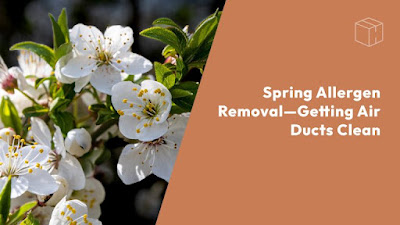Spring Allergen Removal—Getting Air Ducts Clean
Have you experienced chronic ear, throat, or eye irritations, sneezing, coughing, dizziness, or headaches only while in your home and as soon as you use your HVAC system? It could be from poor air quality due to dirty air ducts. Even the American Lung Association recognizes indoor air quality as the catalyst for many allergy-related diseases. If you haven’t cleaned your ducts in 4 to 5 years, there will be an accumulation of contaminants such as dust, pollen, mold, bacteria, and other allergens recirculating by your HVAC system to the indoor air. Even new construction can pose a threat with its hazardous materials and drywall dust. Consequently, you breathe these particles in, leading to allergic and asthmatic symptoms. Indoor allergies are most prevalent during spring and summer when your HVAC starts moving air around, and any particles that have settled there through the winter will kick up and begin affecting your breathing.
Types of Allergens—Some leading contaminants that can settle in your air ducts and later in your lungs are dust mites, mold, pet dander, pollen, smog, and volatile organic compounds. The EPA says these particles much more contaminate indoor air than outside. Dust mites are organisms that produce waste that gets circulated in your air ducts along with pollen after it is brought in through our clothes and shoes. Mold, caused by moisture, releases airborne spores, and pet dander or dead skin flecks from domestic pets can also cause allergic reactions and illness. Smog from C02 emissions and damaging gases from organic compounds can also become part of our home’s indoor environment, thereby detrimental to our respiratory health.
The process and benefits of duct cleaning— Air duct cleaning is important and recommended by allergists to help you breathe healthier, fresher air by improving air quality and reducing allergy symptoms. If you’ve never had your ducts cleaned, don’t have the time, or lack the skills needed to clean them yourself, it’s always best to hire a professional who will possess the appropriate tools and expertise. With a rotary brush or air whip, a professional can clean and sanitize your ducts by flushing or pulling out dust and debris with a vacuum device that uses compressed air. The price will depend on the size and location of your home and the company you choose, so shop around without squelching on quality service. Duct cleaning takes about two hours for the average home and should be done twice yearly. If you’d rather do some of the work yourself, there are simpler tasks, such as changing the HVAC filter or wiping down the surface of the unit. If vacuuming, use a HEPA filter.
In addition to improving air quality, duct cleaning removes odors, reduces surface dust, and improves HVAC efficiency. Smells from pets, rodent droppings, mold, and mildew are removed, and dust from mites and pollen that settle on bed linen and carpets is reduced. Airflow is improved when ducts are unclogged of debris, thus leading to lower energy costs and extending the system’s life.
You should never compromise your indoor air quality by letting spring allergens run amok. You can keep yourself healthy and your HVAC system in good working order by following a regular maintenance plan for cleaning your air ducts. Although the procedure to sanitize and disinfect could be costly, it’s money well-spent as opposed to racking up enormous energy and medical bills. When you invest in cleaning your air ducts, you invest in your health and happy home, so make it a priority for this season.






